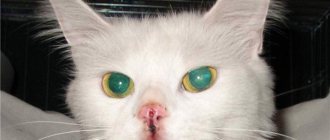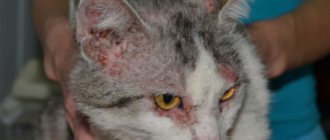The skin is the largest organ of the body. Its functions are not only to protect the body from adverse environmental factors, but also to protect internal soft tissues from injury. In addition, the skin is a supporting aspect for the entire musculature.
Being a natural barrier against a huge number of pathogenic pathogens and viruses that contribute to the occurrence of various diseases, the skin takes the first blow. The owner's attention should not ignore damage to the pet's skin, since any wound or ulcer on the skin is an excellent breeding ground for the proliferation of bacteria and other infectious agents.
The skin performs not only protective functions. The role of the skin is to produce certain vitamin substances, as well as to ensure normal thermoregulation (heat exchange between the body and the environment) and to remove toxic substances from the body.
Emerging skin problems have a sharply negative impact on the overall health of the animal. The immune system suffers, the functional characteristics of internal organs and tissues are disrupted. If the owner notices the appearance of wounds on the cat’s skin, scratches or ulcers that do not heal for a long time, it is not recommended to waste time and self-medicate. It is advisable to immediately consult a veterinarian for advice.
This is due to the fact that veterinary medicine has registered dozens and hundreds of skin diseases with various forms of manifestations and similar symptoms, so that even a highly qualified doctor without preliminary laboratory diagnostics will not be able to make the correct diagnosis and prescribe the correct treatment.
It is important to remember that before going to a veterinary hospital, it is not advisable to treat damaged areas of the skin with complex ointments, as this can complicate the diagnostic process and also give incorrect research results.
What can sores on a cat's back mean?
There are several causes of back pain in cats. The most common :
- Fleas, when biting a pet, leave wounds that, although tiny, can be very itchy. The animal scratches the affected areas, which aggravates the situation. The risk of infection cannot be excluded, which leads to the formation of sores. Fleas are the most common cause of such troubles.
- Allergies can also cause sores in cats. It can be triggered by food, household chemicals and hygiene products, dust, smoke, etc. In addition to skin lesions that itch, other symptoms may be present - watery eyes, nervousness, digestive disorders, coughing, sneezing, nasal discharge. Quite often, taurine, which is part of some cat foods, provokes an allergic reaction.
- Ringworm. The sores with it have a characteristic appearance. This is not a rash, not nodules, but spots with bare pink skin, which over time become covered with brown dry crusts. They fall off over time when the animal scratches the sore. As a result, the wound becomes wet, often bleeding, and is very annoying for the pet. Ringworm tends to spread quickly and take over larger and larger areas of the unfortunate animal's body. Its other name is dermatophytosis (dermatophytes are fungi that cause the disease).
- Demodicosis is diagnosed if sores appear on the cat’s back along the ridge. The development of this pathology is provoked by mites, which, when they get under the pet’s skin, begin to destroy the dermis with their vital activity, and as a result, serious lesions appear. The disease is considered dangerous. May lead to death of the animal. It cannot be treated in advanced stages.
Of course, with all these diseases, sores can appear not only on the cat’s back, but also on the skin of the neck, ears, head, tail and other parts of the body. However, their development often begins from the back.
Poor nutrition
Unbalanced, improper feeding leads to the development of various diseases. Usually the liver, urinary system, and digestive organs are affected. Diseases manifest themselves with specific symptoms. The main mistake owners make is allowing or purposefully feeding food from their table. However, human food is strictly prohibited for cats, especially sweet, fatty, and fried in oil. It leads to serious stress on the entire body. Mixing natural food with dry food is also a common mistake. With this diet, severe diseases of the liver and digestive system are observed. They lead to the formation of wounds on the tail and other parts of the body.
What actions should I take?
Sores on the back along the cat’s spine (as well as in other places) cannot be ignored. The animal needs help. It all depends on the reason.
If the owner is sure that the cat is being attacked by parasites, and the sores are caused precisely by their bites, the animal should be treated for fleas. Today there are enough products on sale that will help quickly solve the problem. The wounds themselves can be treated with an antiseptic to prevent infection and speed up the healing process.
If you suspect that skin problems are the result of an allergy, you can try to review your pet's diet. However, it is not always possible to guess which product caused the reaction, and time passes, and the cat needs to be treated. Therefore, it is better not to take risks, but to immediately show the animal to a veterinarian. He will take tests, determine the irritant and tell you how to deal with the cause of the sore.
This also applies to other situations where the lesion on the back is similar to lichen or demodicosis. You should not engage in amateur activities. Professional diagnosis is required, and then serious treatment . It often involves taking antifungal, anti-inflammatory, and antibacterial drugs.
Only competent advice from a specialist, complex therapy and the caring hands of the owner can quickly alleviate the cat’s condition and eliminate sores without consequences.
List and description of possible causes
The appearance of scabs along the ridge always indicates the development of one of the following diseases in a cat:
- Allergy. The most common reason why cats develop scabs under their fur is redness, swelling, flaking, severe itching, and hair loss all over the body. Food allergies almost always manifest themselves acutely immediately after the irritant enters the body. Within 1-2 days, all symptoms appear and if left untreated, the acute form can transform into chronic. This means that from time to time the pet will exhibit all the symptoms described above with varying intensities. Another common cause of scabs on a cat's back can be flea dermatitis. An allergic reaction to flea bites or saliva.
- Fleas. They can become real torture for a cat if the owner ignores regular treatments for parasites. In 90% of cases, scabs under the fur on the back appear as a result of an allergic reaction to flea saliva. The problem is successfully eliminated with the help of modern drugs Stronghold, Frontline, Advantage, Advocate, etc. A prerequisite is the treatment of all animals living in the house. It also doesn’t hurt to disinfect the premises if the parasites get to your pet from the outside.
- Lichen. A fungal infection of the skin that is particularly contagious and can be contagious to humans. Often found in homeless animals. You can become infected after close contact with an affected pet or through fungal spores getting into the fur. The clinical picture, although it has its own characteristics, always proceeds differently. Distinctive areas include characteristic crusts under the fur, similar to dandruff or flaking. As the process progresses, a bald spot appears in this area. In severe cases, the area begins to become wet and bleed. Itching is present in every second case. Diagnosis of lichen is also not simple, since it must be distinguished from flea dermatitis and parasites. This may require illumination of the lesions under a Wood's lamp, microscopic examination of hairs and pieces of skin taken from the plaques. If doubts arise after this, then a fungal culture taken from the crusts is sown. The result becomes known in 7-10 days. Only after determining the fungal culture can effective drugs be selected for treatment. In 90% of cases, the causative agent is dermatophytes, the rest is due to yeast and mold fungi. The treatment itself is long-term, using local treatments of the affected areas (Zalain) and taking antifungal drugs (Terbinafine) orally. The use of special shampoos (Nizoral) during bathing also showed good effectiveness. Particular attention is paid to disinfecting the home, since fungal spores can survive up to 18 months in the environment. To avoid relapses, be sure to carry out wet cleaning with solutions of chlorhexidine, miramistin and bleach added to the water. All woolen items and fabrics that an infected animal comes into contact with are treated with a steam generator.
- Bacterial damage. It often appears on the back in the form of dry crusts. It may occur against the background of an allergic reaction or fungal infection. Along with the crusts under the fur, you can see redness and slight swelling of the skin. In case of a bacterial infection, the underlying disease is always taken under control. Otherwise, re-inflammation is only a matter of time. Steroid ointments Akriderm or Triderm can be used as treatment. Using them without a prescription from a veterinarian, who will determine the required dosage, is dangerous for the pet’s health.
- Demodecosis. Very common along the spine. At the initial stage it appears in the form of small black rashes, which transform into dry crusts over the course of the process. Itching is practically absent, but a bald patch appears at the site of the lesion. Often found in kittens; in adults, the activity of the subcutaneous mite can provoke serious diseases of the internal organs or tumor processes. Do not forget that demodicosis is not contagious and is not dangerous for other animals or humans. Single lesions can go away on their own. When the process spreads throughout the body, they search for and eliminate the underlying disease that provoked the activity of the tick.
Tail hair loss
The following symptoms symbolize this problem::
- the presence of bald spots;
- on the upper part of the tail, at its base, the hair has become greasy, greasy and constantly rolls down;
- Under the fur you can find a discharge that is oily and brown in color.
The cause of tail baldness may be a disruption in the functioning and functionality of the glands that produce fat. If fat production is disrupted, then the above changes occur, the skin balance is disrupted and the pet suffers.
Photo of a cat with scabs on its back
Separately, I would like to remind you that vaccination against lichen is ineffective, so you should not torment your pet with unnecessary vaccinations.
What does a skin sore look like in cats?
The external features of the sores vary depending on the diagnosis. Scabs and dry crusts that form during wound healing may be observed on the cat's body. They are often small in size.
Pustules, small, hard, red nodules, may also be present. Their number varies from 1 to several dozen. They can be located not only on the back, but also on the neck of the animal, near the tail.
Often hair begins to fall out next to the scabs. If the itching is too severe, the cat may scratch the affected area of the body. Redness on the skin is possible.
Inflammation caused by fungi or bacteria
Colonies of opportunistic microorganisms constantly live on the skin of domestic cats, which, in most cases, do not manifest themselves in any way. However, at some points in life, when a cat’s body is weakened by some disease or experiences an acute lack of vitamins, populations of pathogenic bacteria increase sharply. The consequence of such immune failures is not only a deterioration in the condition of the skin, but also in the general well-being of the animal. In this case, it is difficult for the owner to immediately suspect the cause of the disease, so it is necessary to pay close attention to increased skin itching.
Skin inflammation can be caused by bacteria or fungus, as appropriate tests will show. In such cases, comprehensive treatment of the animal will be required, because inflammation of the skin is not the main cause of the disease.
One of the most common diseases that causes itching is pyodermatitis. This infection is of bacterial origin and is localized not only on the surface of the skin, but also in deeper layers.
The main reasons for the appearance
The most common reasons for the appearance of formations on a pet’s body are:
- parasite bites (fleas and ticks);
- allergic reactions;
- infectious processes on the skin;
- reactions to severe stress (for example, moving or getting another pet).
Allergy to flea bites or food
Most often, pustules are observed in cats with increased sensitivity to flea bites. An allergic reaction can be caused by insect saliva. Rashes appear only at the sites of bites.
Most often they can be found in the area of the tail, neck, and chin. The size of the wounds is 0.3-1 cm. Often the kitten begins to scratch the affected areas, which leads to bleeding.
Treatment consists of removing parasites. Not only the animal itself should be treated, but also its things: bed, toys, scratching post. All surfaces in the room to which the cat has access are also treated.
The cause of scabs can also be an allergy to food. The rashes are localized on the head and neck. Partial hair loss, vomiting, and stool disturbances are possible. The pet licks the affected areas. The reaction should not be seasonal.
By changing the food or eliminating the product that caused the adverse reaction from the diet, the symptoms will quickly disappear. Treatment is changing your diet.
Skin diseases and bacterial infections
With contact dermatitis, the rash occurs in areas with the least amount of fur: the ears, paws, and underbelly. It is a reaction to any irritant: a plant, cosmetics, medicine. When the allergen is eliminated, after a course of taking antihistamines, the sores will disappear.
Ringworm is manifested by the formation of round plaques on the skin. In their place, hair falls out and the skin is very itchy. It should be treated with special shampoos and medications. All other animals will also have to be processed. People should be careful when coming into contact with an infected cat.
Bacterial skin infections
In cats, primary bacterial skin infections are rare (with the exception of subcutaneous abscesses due to trauma), as a rule, they are associated with immune and metabolic disorders. Predisposing factors are allergies (photo 2), hyperthyroidism, diabetes mellitus, immunosuppression (FIV, FLV, calicivirosis and others). The exception is superficial pyoderma in kittens (juvenile impetigo) due to excessive grooming. The main microorganism causing pyoderma is coagulase-positive Staphylococcus pseudointermedius
, as well as
Pasteurella multocida, Streptococcus sp.
(hemolytic strains)
, Actinomyces sp., Bacteroides sp., Fusobacterium sp.
In cytological preparations for pyoderma, there is a marked increase in the number of neutrophils, including the presence of degenerative leukocytes, some of which may contain intracellular bacteria. Eosinophils are rare. The presence of yeast fungi Malassezia sp. is also possible,
especially with intertrigo complex.
Treatment consists of eliminating the causes and antimicrobial therapy. Only local use of drugs (chlorhexidine, miramistin, povidone-iodine and others) is effective in eliminating the causes of erosive lesions. For ulcers, there is a need for systemic antibiotic therapy: amoxicillin + clavulanate 12.5 - 25 mg/kg po every 12 hours, cephalexin 25 mg/kg po every 12 hours, enrofloxacin 5 -10 mg/kg po every 12 hours and others. In chronic cases, the material can be sent for microbiological testing (isolation of bacterial and fungal cultures and antibiotic sensitivity testing).
External symptoms: cat behavior
To make a correct diagnosis, you need to observe changes in the pet's behavior. Cats may become restless and irritable if they suffer from ticks and insects.
Infectious pathologies often cause lethargy and apathy, refusal to eat, and play with their owners. In addition, most often sores cause physical discomfort to the pet, which leads to the need to scratch or intensively lick the affected area.
We invite you to watch this video:
Disturbances in the hormonal system
Deficiency or excess of certain hormones leads to imbalance and endocrine disorders. They are usually accompanied by various pathologies - alopecia, excess weight, changes in appetite and behavior. Diabetes mellitus is one of the most dangerous diseases. It is often observed in overweight animals. The provoking factor is often a failure in carbohydrate metabolism and insulin regulation. A characteristic sign of diabetes mellitus is the appearance of deep, poorly healing wounds on the tail. Sometimes wet erosion can be replaced. Wounds appear in this place due to the characteristics of the blood supply. Treatment of obesity - adjusting the diet, switching to dietary nutrition. For diabetes - medications to lower blood sugar levels, food for cats with diabetes, moderate physical activity, and insulin if necessary.
Diagnosis of causes
It is not recommended to make a diagnosis yourself. It is necessary to show the cat to the veterinarian. First, the specialist will perform an external examination of the sick animal, after which he will interview the owners about any additional symptoms observed.
The doctor can clarify whether there is a connection between the appearance of symptoms and the time of year, whether the onset of sores was preceded by sudden changes in lifestyle, whether the food has changed, whether the animal has taken medications (including anti-parasitic drugs), and whether vaccinations have recently been given.
Diagnostic tests will be performed if necessary. If ringworm is suspected, an ultraviolet lamp is used. The presence of parasites and fungi is checked using skin scrapings. A number of infectious pathologies are confirmed by biopsy results. If a food allergy is suspected, the animal will be placed on a hypoallergenic diet.
General treatment tips
You cannot select medications and dosages on your own. The choice should be made by a veterinarian, taking into account the diagnosis and individual characteristics of the cat. Before contacting a veterinarian, Miramistin is allowed to be used. This broad-spectrum drug rarely causes unwanted reactions or complications.
Be sure to complete the course of treatment to the end. If you stop using medications at the first improvement, the disease may recur and become chronic . It will be necessary to take more aggressive medications to cure the cat, both to alleviate the symptoms and to eliminate the cause of the disease.
You cannot refuse treatment. Since the sores cause severe discomfort to the cat, she can scratch them, violating the integrity of the skin. This increases the risk of infection entering the wounds. Purulent complications are possible.
During treatment, medications should not be given without the permission of the veterinarian. Before giving your cat any drug, including dewormers, you need to check its compatibility with the medications used for treatment.
A sick animal should also not be vaccinated: due to a weakened immune system, the reaction can be unpredictable and complications are possible.
Many pathologies are transmitted to people, so owners should follow safety rules when treating a cat so as not to become infected. In some cases, the veterinarian recommends preventative treatment for family members. Do not neglect such recommendations. There is no need to walk a sick cat, as it can easily infect other animals. The risk of complications will also increase on the street.
What to do if your cat has back pain
Author: Elena(admin) March 2, 2017
The crusts can be described as pustules, or small, hard, red nodules. Their number can vary from one to several dozen. The type of sore, location, and accompanying symptoms can help your veterinarian determine the cause. Sores on your cat's neck and back (especially close to the tail) may indicate hypersensitivity to flea bites. Sores around your cat's head and ears may be due to food allergies. Sores on a cat's chin are usually caused by acne. Seasonal itching, accompanied by scratching and dry sores, indicates an allergy.
Hypersensitivity to flea bites
The most common cause of sores in cats is hypersensitivity to flea bites. Cat fleas are wingless parasites; adult fleas live on the cat's body, feeding on its blood. Many cats develop an allergy to flea saliva, whose bites cause a localized reaction. Small sores can be found at the base of the cat's tail, around the neck and on the chin (see photo). The size of scabs varies in diameter from 3 mm to 1 cm or more. Excessive scratching can cause the sores to bleed.
Neoplasms
Proliferative ulcerated skin lesions in cats, especially solitary lesions, should always raise red flags for neoplasia. Blastomatous ulcers are formed as a result of the breakdown of tumor tissue. Cytological signs of malignancy of neoplasms are: anisocytosis (change in cell size), pleomorphism (change in cell shape), change in the color intensity of the cytoplasm, anisokaryosis (change in the size of the nuclei), change in the size and shape of the nucleoli, change in the value of the nucleus/cytoplasm ratio. The most common examples of tumors leading to the formation of ulcerative skin lesions in cats are basal cell carcinomas (photo 5), squamous cell carcinoma, mastocytomas (photo 9), less commonly ceruminomas and tumors of the sebaceous glands, tumors of mesenchymal origin (fibrosarcomas, angiosarcomas and others). Erosions and ulcers in the abdominal area, accompanied by lumps in and under the skin, are often associated with breast carcinomas (Figure 7).










